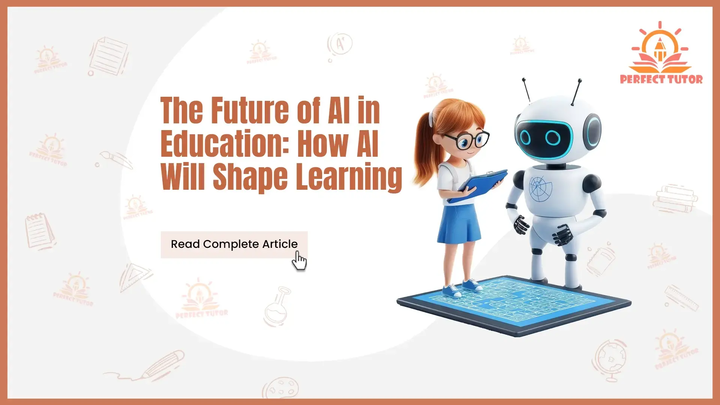The Future of AI in Education: How AI Will Shape Learning
Education is evolving faster than ever, and one of the driving forces behind this change is artificial intelligence (AI). This blog explores how AI is transforming the way students learn, teachers teach, and institutions work. From personalized learning experiences to simplifying administrative tasks, the potential of AI is enormous.
By reading this blog, you will understand the main ways AI is impacting education, the benefits it offers, and 10 important things to know about how AI is revolutionizing the education system. Whether you are a teacher, a student, or a parent, this blog will give you a clear picture of how AI is paving the way for smarter, more efficient education.
How AI Is Shaping the Future of Education
Let us explore some of the key areas where AI is making a difference and paving the way for the future of learning.
1. Personalized Learning for Every Student
AI is revolutionising education by delivering personalised learning experiences. Instead of a one-size-fits-all approach, AI-powered platforms deliver customised lessons by analysing a student’s strengths, weaknesses, and preferences. This ensures that every student progresses at their own pace, building confidence and improving outcomes.
For example, adaptive learning software can recommend specific exercises or videos to reinforce areas where the student has difficulty, creating a unique learning path for each individual.
2. On-Demand AI Tutors
AI tutors are becoming an essential tool for students who need extra support outside of the classroom. These digital tutors provide real-time assistance by breaking down complex topics into easy-to-understand explanations. Whether it's solving a tricky math problem or mastering a new language, AI tutoring systems are always available to guide students.
Unlike traditional tutoring, AI tutors are available at any time and can meet the needs of learners around the world, ensuring no one gets left behind.
3. Empowering Teachers with Smart Tools
AI isn't just for students—it's valuable for teachers, too. By automating routine tasks like grading assignments, tracking attendance, and organizing resources, AI frees teachers to focus on the most important job: teaching and guiding students.
AI-powered analytics also provide information about student performance, helping teachers identify areas that need attention. This allows for early intervention and more effective teaching strategies.
4. Smarter Classrooms with AI
The classroom is no longer limited to four walls. AI-powered smart systems are transforming traditional classrooms into interactive learning hubs. These systems include the following tools:
Virtual teaching assistant to answer student queries.
Smart whiteboards that integrate online resources.
Voice recognition tools that help in learning languages.
5. Globalizing Education with AI
The future of AI in education transcends borders. AI tools enable students from different parts of the world to access the same high-quality resources. For example, AI-powered translation systems can make courses available in multiple languages, promoting cross-cultural learning and collaboration.
AI-powered virtual classrooms are another step towards connecting learners and teachers globally, creating a truly international education system.
6. AI-Enhanced Learning Content
AI is changing the way educational content is created. By analyzing curriculum standards and student data, AI can create engaging lesson plans, quizzes, and even interactive simulations.
For example, AI can create customized study guides for exam preparation or interactive tools for hands-on learning in subjects like science and engineering. This ensures that students are learning with the best resources available.
7. Smarter Administrative Systems
AI is streamlining administrative tasks, making educational institutions more efficient. From managing student admissions to optimizing class schedules, AI tools handle time-consuming processes, saving schools valuable resources.
Predictive analytics can also help institutions anticipate enrollment trends and allocate resources effectively, ensuring smooth operations.
8. Improving Assessments and Feedback
AI-powered systems are revolutionizing the way students are assessed. These systems can evaluate open-ended responses, essays, and even creative projects, and provide immediate and detailed feedback.
Such tools not only save teachers’ time but also help students understand their mistakes and improve their performance more quickly.
9. Enhancing Remote and Hybrid Learning
AI is vital to making remote and hybrid learning more effective. Virtual classrooms equipped with AI tools can track student participation, recommend personalized resources, and even provide virtual teaching assistants.
AI-powered platforms ensure that online education is engaging and interactive, and bridge the gap between traditional classrooms and distance learning.
10. Career Pathway Guidance
AI can also assist students in planning their future. By analysing individual skills, interests and academic performance, AI systems can suggest career paths, recommend relevant courses and even connect students with internships or mentors in their chosen fields.
This personalized guidance helps students make informed decisions about their education and careers.
Read also :- Revolutionizing Learning: How Important Is Technology in Education?
The Future of AI in Education System
As we look ahead, it is clear that AI will continue to shape the future of the education system. With personalized learning, better teacher support, and improved administrative processes, AI has the power to transform the way education is delivered. However, it is important to note that AI will not replace teachers but rather enhance their capabilities, allowing them to focus on the creative and interactive aspects of teaching.
Educational institutions and educators must embrace these advancements to ensure that the full potential of AI is realized. By integrating AI into everyday learning, we can create more inclusive, efficient, and engaging educational experiences for students everywhere.
Challenges to Address in the Future
While AI offers countless opportunities, it also comes with challenges:
Cost: Implementing an AI system can be costly for schools.
Privacy Concerns: The security of students' data is important.
Teacher Training: Educators need to learn how to use AI effectively.
Addressing these challenges will ensure a balanced and ethical use of AI in the future.
Artificial Intelligence and the Future of Education: What’s Next?
The integration of AI in education will not replace teachers but enhance their role. Teachers will become advisors and guides, focusing on emotional and social development while AI will handle repetitive tasks.
On the other hand, students will experience a more engaging and interactive learning journey. They will have access to a global pool of resources and personalized learning paths, making education more inclusive and efficient.
FAQs About the Future of AI in Education
Q1. What is the future of AI in education?
AI will personalize learning, automate administrative tasks, and make education more accessible around the world.
Q2. How does AI benefit education systems?
It increases teaching efficiency, provides support to students with disabilities, and improves learning outcomes with real-time feedback.
Q3. Can AI replace teachers in the future?
No, AI helps teachers complete repetitive tasks, allowing teachers to focus on guiding students.
Q4. How does AI help students with special needs?
AI tools like text-to-speech, real-time subtitles, and sign language recognition make learning accessible for all students.
Q5. How will AI change the education system?
AI will transform the education system by tracking student performance, providing personalized learning resources, and enabling more efficient teaching and administrative processes. This will make education more accessible.
Q6. What are some examples of AI in education?
Some examples of AI in education include AI-powered tutoring, personalized lesson plans, virtual classrooms, learning analytics, and intelligent content creation. These tools help students learn more effectively and assist teachers in providing better support.
Q7. How can AI help students with disabilities?
AI can assist students with disabilities by providing tools such as speech recognition, text-to-speech, and real-time captions. These technologies make learning more accessible for students with visual, hearing, or learning disabilities.
Q8. Will AI replace teachers in the future?
No, AI will not replace teachers. Instead, it will enhance their role by automating administrative tasks, providing personalized learning support, and providing information about students' performance, allowing teachers to focus more on teaching and guidance.
Conclusion: A Bright Future for Education with AI
The future of AI in education is bright and full of possibilities. From personalized learning to smart tutoring systems, AI is set to transform the way we teach and learn. By automating administrative tasks, enhancing learning resources, and providing real-time feedback, AI will help create more efficient, engaging, and accessible educational experiences. Both students and teachers will benefit from AI-powered tools that will improve the quality of education and support lifelong learning.
The future of AI in education isn't just about technology - it's about making learning more effective, engaging, and inclusive for everyone. As AI continues to evolve, so will the opportunities for students and teachers to thrive in an increasingly interconnected world.



 +91 8700847275
+91 8700847275
 +1 8009616567
+1 8009616567